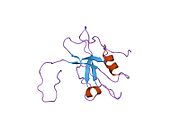PDZRN3
Protein-coding gene in the species Homo sapiens
| PDZRN3 | |||||||||||||||||||||||||||||||||||||||||||||||||||
|---|---|---|---|---|---|---|---|---|---|---|---|---|---|---|---|---|---|---|---|---|---|---|---|---|---|---|---|---|---|---|---|---|---|---|---|---|---|---|---|---|---|---|---|---|---|---|---|---|---|---|---|
 | |||||||||||||||||||||||||||||||||||||||||||||||||||
| |||||||||||||||||||||||||||||||||||||||||||||||||||
| Identifiers | |||||||||||||||||||||||||||||||||||||||||||||||||||
| Aliases | PDZRN3, LNX3, SEMACAP3, SEMCAP3, PDZ domain containing ring finger 3 | ||||||||||||||||||||||||||||||||||||||||||||||||||
| External IDs | OMIM: 609729; MGI: 1933157; HomoloGene: 10328; GeneCards: PDZRN3; OMA:PDZRN3 - orthologs | ||||||||||||||||||||||||||||||||||||||||||||||||||
| |||||||||||||||||||||||||||||||||||||||||||||||||||
| |||||||||||||||||||||||||||||||||||||||||||||||||||
| |||||||||||||||||||||||||||||||||||||||||||||||||||
| |||||||||||||||||||||||||||||||||||||||||||||||||||
| |||||||||||||||||||||||||||||||||||||||||||||||||||
| Wikidata | |||||||||||||||||||||||||||||||||||||||||||||||||||
| |||||||||||||||||||||||||||||||||||||||||||||||||||
PDZ domain-containing RING finger protein 3 is a protein that in humans is encoded by the PDZRN3 gene.[5][6]
References
- ^ a b c GRCh38: Ensembl release 89: ENSG00000121440 – Ensembl, May 2017
- ^ a b c GRCm38: Ensembl release 89: ENSMUSG00000035357 – Ensembl, May 2017
- ^ "Human PubMed Reference:". National Center for Biotechnology Information, U.S. National Library of Medicine.
- ^ "Mouse PubMed Reference:". National Center for Biotechnology Information, U.S. National Library of Medicine.
- ^ Kikuno R, Nagase T, Ishikawa K, Hirosawa M, Miyajima N, Tanaka A, Kotani H, Nomura N, Ohara O (Oct 1999). "Prediction of the coding sequences of unidentified human genes. XIV. The complete sequences of 100 new cDNA clones from brain which code for large proteins in vitro". DNA Res. 6 (3): 197–205. doi:10.1093/dnares/6.3.197. PMID 10470851.
- ^ "Entrez Gene: PDZRN3 PDZ domain containing RING finger 3".
Further reading
- Bach I, Rodriguez-Esteban C, Carrière C, et al. (1999). "RLIM inhibits functional activity of LIM homeodomain transcription factors via recruitment of the histone deacetylase complex". Nat. Genet. 22 (4): 394–9. doi:10.1038/11970. PMID 10431247. S2CID 22326394.
- Strausberg RL, Feingold EA, Grouse LH, et al. (2003). "Generation and initial analysis of more than 15,000 full-length human and mouse cDNA sequences". Proc. Natl. Acad. Sci. U.S.A. 99 (26): 16899–903. Bibcode:2002PNAS...9916899M. doi:10.1073/pnas.242603899. PMC 139241. PMID 12477932.
- Ota T, Suzuki Y, Nishikawa T, et al. (2004). "Complete sequencing and characterization of 21,243 full-length human cDNAs". Nat. Genet. 36 (1): 40–5. doi:10.1038/ng1285. PMID 14702039.
- Katoh M, Katoh M (2004). "Identification and characterization of PDZRN3 and PDZRN4 genes in silico". Int. J. Mol. Med. 13 (4): 607–13. doi:10.3892/ijmm.13.4.607. PMID 15010864.
- Hassel S, Eichner A, Yakymovych M, et al. (2004). "Proteins associated with type II bone morphogenetic protein receptor (BMPR-II) and identified by two-dimensional gel electrophoresis and mass spectrometry". Proteomics. 4 (5): 1346–58. doi:10.1002/pmic.200300770. PMID 15188402. S2CID 6773754.
- Santin AD, Zhan F, Bellone S, et al. (2004). "Gene expression profiles in primary ovarian serous papillary tumors and normal ovarian epithelium: identification of candidate molecular markers for ovarian cancer diagnosis and therapy". Int. J. Cancer. 112 (1): 14–25. doi:10.1002/ijc.20408. PMID 15305371. S2CID 29845339.
- Meyer G, Varoqueaux F, Neeb A, et al. (2005). "The complexity of PDZ domain-mediated interactions at glutamatergic synapses: a case study on neuroligin". Neuropharmacology. 47 (5): 724–33. doi:10.1016/j.neuropharm.2004.06.023. PMID 15458844. S2CID 11771522.
- Gerhard DS, Wagner L, Feingold EA, et al. (2004). "The status, quality, and expansion of the NIH full-length cDNA project: the Mammalian Gene Collection (MGC)". Genome Res. 14 (10B): 2121–7. doi:10.1101/gr.2596504. PMC 528928. PMID 15489334.
- v
- t
- e
PDB gallery
-
 1uhp: Solution structure of RSGI RUH-005, a PDZ domain in human cDNA, KIAA1095
1uhp: Solution structure of RSGI RUH-005, a PDZ domain in human cDNA, KIAA1095 -
 1wh1: Solution structure of the fourth PDZ domain of KIAA1095 protein
1wh1: Solution structure of the fourth PDZ domain of KIAA1095 protein
 | This article on a gene on human chromosome 3 is a stub. You can help Wikipedia by expanding it. |
- v
- t
- e


















